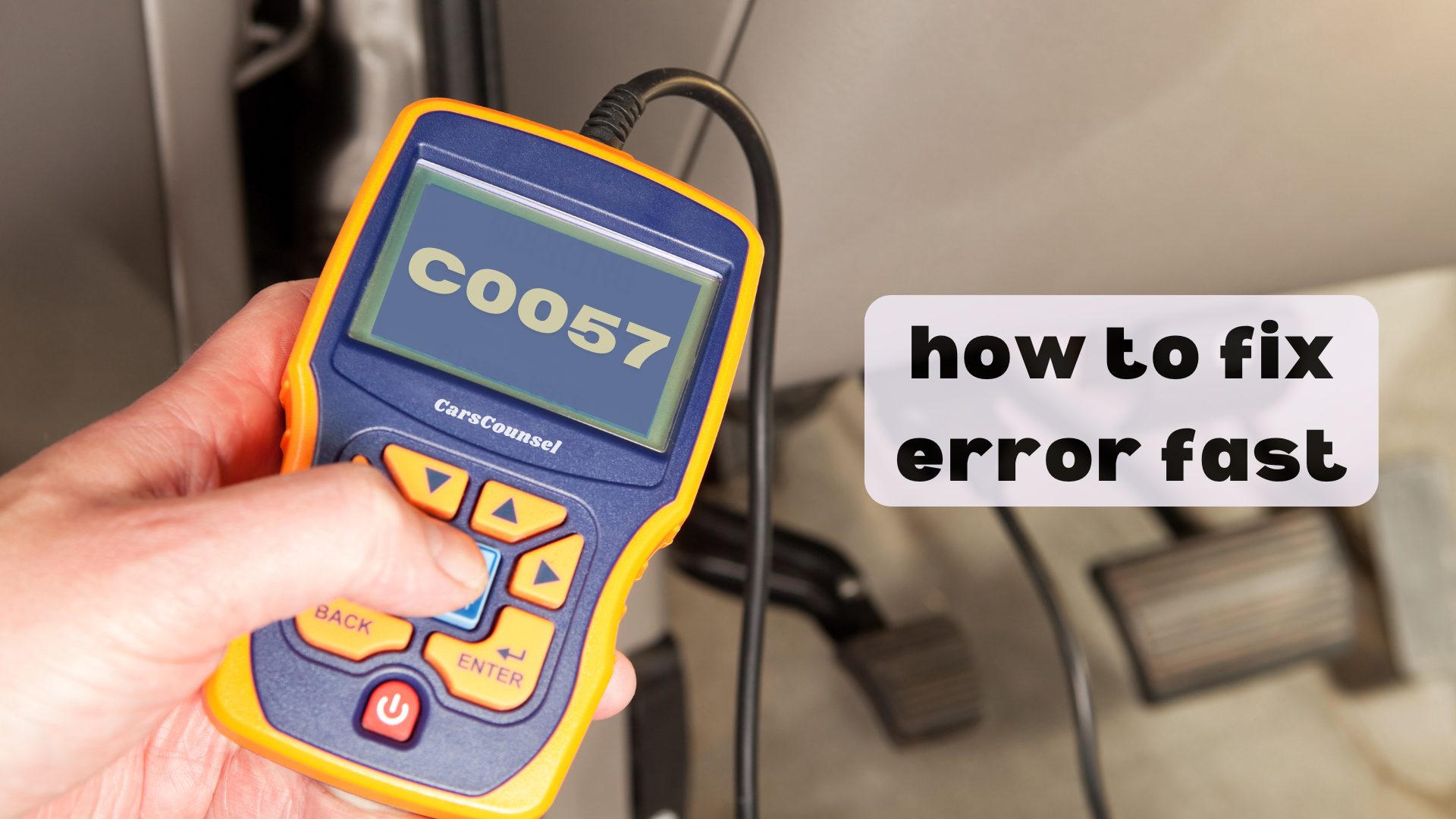Did you know that nearly 20% of all car error codes are related to sensor problems?
If you’ve come across the C0057 code, it means your steering angle sensor might be acting up. This can cause serious safety issues while driving, so it’s important to fix it quickly.
You’ll need to confirm the error code with an OBD2 scanner, check the sensor, and make sure all the wires are connected properly.
But what’s the best way to do each of these steps without missing anything important?
Let’s find out how you can fix this error quickly and efficiently.

Quick Navigation
Key Takeaways
- Use an OBD2 Scanner: Plug in an OBD2 scanner to find out what the error codes are and pinpoint the problem.
- Look at the Sensor: Check the steering angle sensor to see if it’s damaged. Replace it if needed.
- Check the Wiring: Look at the wiring for any cuts, rust, or loose connections. Fix or replace the wiring as necessary.
- Check the Battery: Make sure the battery has a stable voltage and clean the terminals. Get a new battery if the voltage is low.
What Is the C0057 Code?
The C0057 code means there’s a problem with the steering angle sensor, which is crucial for keeping your car stable, especially when you’re making turns.
This sensor tracks the position of the steering wheel and sends this information to your car’s computer to make real-time adjustments.
If the sensor isn’t working right or isn’t calibrated properly, your car’s handling can become unpredictable, making it a safety risk.
Fixing this issue quickly is essential to ensure your vehicle stays safe and performs well on the road.
Common Symptoms
When the C0057 code pops up, it means there might be a problem with your steering angle sensor. Here are some things you might notice:
- Your steering mightn’t respond as well, making it harder to control the car, especially when turning.
- The steering could feel off or jerky.
- You might see the ABS warning light on your dashboard.
- The car could pull to one side, which can make driving unsafe.
It’s important to get this checked out quickly to make sure your car’s steering works well and to prevent more issues.
Primary Causes
When diagnosing the C0057 code, a faulty steering angle sensor is often the main issue. Problems with sensor calibration can cause incorrect readings, leading to this error code. It’s important to check the electrical system because damaged or corroded wires can interfere with the sensor’s communication. Low battery voltage can also affect the sensor’s performance. Additionally, moisture and debris in the environment can cause the sensor to malfunction. Software issues in the vehicle’s computer system might also trigger the C0057 code.
| Primary Cause | Description | Solution |
|---|---|---|
| Faulty Sensor | Wear and tear causing malfunction | Replace sensor |
| Wiring Issues | Damaged or corroded wiring | Repair or replace wiring |
| Low Battery Voltage | Insufficient voltage affecting sensor function | Charge or replace battery |
| Environmental Factors | Exposure to moisture or debris | Clean and protect sensor area |
| Software Glitches | Issues in vehicle’s computer systems | Update or recalibrate software |
Impacted Car Models
Several car models, including popular ones like the Honda Accord and Chevy Malibu, are more likely to have issues with the C0057 code because of problems with the steering angle sensor.
For the Honda Accord, these problems often come from certain years where the sensor isn’t very durable.
Chevy Malibu had recalls in 2004 and 2009 because of ongoing issues with this sensor, raising safety concerns.
Other models that also have frequent sensor problems include the Ford Fusion, Toyota Camry, and Nissan Altima.
Knowing that these cars are prone to the C0057 code can help you focus on diagnostics and repairs to keep your car safe and running well.
Always check if your car model is affected so you can fix it in time.
Diagnostic Steps
To diagnose the C0057 code effectively, start by using an OBD2 scanner to pinpoint the exact error and any related issues. Next, follow these steps:
- Check the Steering Angle Sensor: Use a multimeter to ensure the sensor is working properly.
- Look at the Wiring: Check for any visible damage and use a multimeter to test the wiring’s continuity.
- Test the Battery Voltage: Measure the battery’s voltage to make sure it’s at the right level.
Here’s a simple guide to help you:
| Step | Tool Needed | Action |
|---|---|---|
| OBD2 Scan | OBD2 Scanner | Identify the error code and related issues |
| Sensor Check | Multimeter | Ensure the sensor is working |
| Wiring Inspection | Multimeter | Check for damage and test continuity |
| Battery Test | Voltmeter | Make sure the voltage is adequate |
Use these troubleshooting steps to efficiently resolve the C0057 code.
Using an OBD2 Scanner
Start by plugging an OBD2 scanner into your car’s diagnostic port to find out more about the C0057 error code and any other related problems.
OBD2 scanners help you read error codes and access live data from your car’s computer. There are different types of scanners, from simple ones that just read and clear codes to advanced ones that can stream live data, create graphs, and even perform checks specific to the car’s manufacturer.
After connecting, follow the scanner’s instructions to read the stored codes. If you see the C0057 code, make a note of any other codes that show up, as they might indicate related issues.
This step is crucial for understanding what’s wrong and figuring out how to fix it.
Inspecting the Sensor
Checking the Sensor
Start by finding the steering angle sensor, which is usually near the steering column or inside the steering wheel assembly. Once you’ve located it, take a good look to see if there’s any visible damage or dirt. If it looks damaged, you might need to replace it. Use a multimeter to test the sensor’s signals to make sure it’s working properly. If the readings are off, you may need to calibrate the sensor.
| Step | Action |
|---|---|
| Find | Look for the sensor near the steering column |
| Look Over | Check for damage or dirt |
| Test with Multimeter | Check the sensor’s signals |
| Adjust if Needed | Calibrate the sensor if the readings are wrong |
| Replace if Needed | Swap out the sensor if it looks damaged |
Checking the sensor properly ensures it’s working right and helps avoid more problems later.
Checking Wiring Issues
After checking the steering angle sensor, it’s important to look at the wiring for any damage or rust. Damaged wiring can mess up the sensor’s connection with the car’s computer, causing the C0057 error code.
Start with a visual check, then use a multimeter to make sure there are no breaks or shorts in the wires.
Here’s how to do it step-by-step:
- Look Over the Wires: Check for any frayed wires, bare spots, or rust.
- Test the Wires: Use a multimeter to see if there are any breaks in the wires.
- Check the Connectors: Make sure all plugs are tight and clean.
- Fix or Replace: Repair any bad wires or replace them if needed.
Testing Battery Voltage
To make sure your steering angle sensor works right, you need to test your car’s battery voltage with a multimeter.
First, turn off your car and find the battery terminals. Put the multimeter probes on the positive and negative terminals. The multimeter should show around 12.6 volts. If it shows much less, there’s a problem.
Keeping your battery in good shape is important for stable voltage. Clean the terminals and check for any rust. A well-kept battery stops low voltage issues that can mess up the steering angle sensor.
If the voltage isn’t stable, you might need to charge or replace the battery. This helps keep your car in good condition and prevents the C0057 error code from coming back.
Effective Repairs
When dealing with the C0057 error code, follow these steps to fix it effectively:
- Replace the Steering Angle Sensor: If the sensor is faulty, get a new one that’s compatible with your vehicle.
- Calibrate the New Sensor: Use a diagnostic tool to ensure the new sensor is properly calibrated.
- Fix Any Wiring Issues: Check for any damaged or corroded wires connected to the sensor and repair or replace them as needed.
- Clear the Error Codes: Use an OBD2 scanner to reset the system and make sure the error code is gone.
More OBD-II Codes
Frequently Asked Questions
Can Driving With a C0057 Code Damage Other Car Components?
Yes, driving with a C0057 code can harm other car parts. It affects steering, which can cause extra wear on suspension parts. Make sure to get the sensor calibrated quickly to keep your car stable and avoid more problems.
How Long Does It Typically Take to Fix a C0057 Code Issue?
Usually, it takes about 1-2 hours to fix the problem. Most of the time, about 70% of repairs just need a sensor replaced. Using diagnostic tools makes the job quicker and helps keep costs down. Don’t forget to check the wiring and battery too.
Are There Any Preventative Measures for Steering Angle Sensor Issues?
You can avoid problems with your steering angle sensor by doing regular maintenance and alignment adjustments. Regular checks and timely fixes ensure the sensor works well, reducing the chance of issues and keeping your vehicle stable.
Will Insurance Cover Repairs Related to a C0057 Code?
Navigating insurance coverage for repair costs can be tricky and really depends on your policy. Usually, standard policies won’t cover repairs for a C0057 code unless it’s related to an accident. Look at your coverage details or reach out to your insurance company to get a clear answer.
Can Aftermarket Sensors Be Used to Fix the C0057 Code?
Yes, you can use aftermarket sensors to fix the code. Just make sure they are compatible with your vehicle and are installed correctly. Check that the replacement sensors meet the manufacturer’s specifications to avoid more problems and keep your vehicle safe.
Conclusion
To quickly fix the C0057 code, start by using an OBD2 scanner to confirm the error.
Look at the steering angle sensor for any damage and test its outputs with a multimeter.
Check the wiring for any corrosion and ensure all connections are tight.
If needed, replace or recalibrate the sensor, then clear the error codes.
Finally, take the car for a test drive to make sure the problem is fixed.
Following these steps will make your car run smoother than ever!

